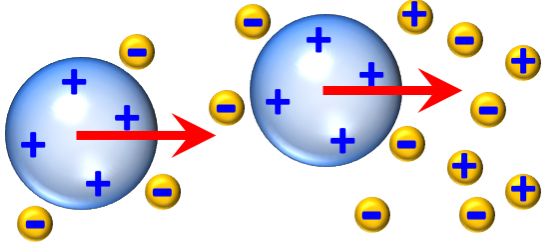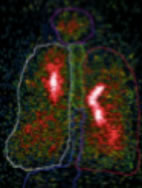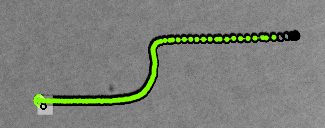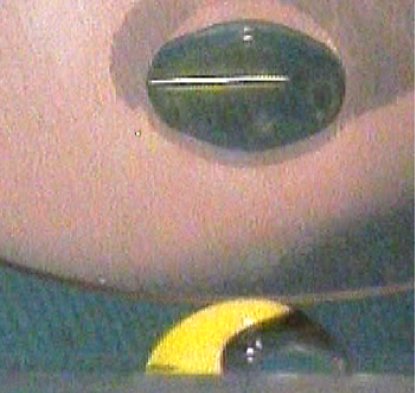| |
Solute Transport and Induced Diffusiophoretic Colloidal Motion
|

|
Deterministic motion of a colloidal-scale species can be induced by the concentration gradient of a surrounding solute. For charged colloids in electrolyte solutions, the concentration gradient of the electrolyte causes motion known as diffusiophoresis. Since the solute concentration in a practical system is usually inhomogeneous, diffusiophoresis plays a role in numerous natural phenomena and applications such as blue energy harvesting, mineral replacement reactions and enhanced oil recovery. Our group has developed mathematical models to predict the transport of solute and diffusiophoretic colloids. Notable results include (i) the demonstration of orders of magnitude increase in the species spreading profile in an eccentric annulus by exploiting symmetry breaking; and (ii) the predictions of anomalous, super/sub-diffusive spreading of diffusiophoretic colloids. Currently, our group is developing experiments to translate these predictions into various applications.
|
| |
Marangoni Driven Spreading
|
| |
For Pulmonary Drug Delivery
|

|
Inhaled aerosol drugs can deliver substantial doses of medication directly to the lungs while minimizing the exposure of the rest of the body to the medication, greatly reducing the possibility of side effects. Antibiotics are often administered this way for treatment of the pulmonary infections associated with cystic fibrosis. Aerosols (fine droplets of liquid suspended in air) are mainly transported through the lung in the air stream during inhalation. However, obstructions in the airways and other consequences of cystic fibrosis lung disease may cause inhaled droplets containing drugs to be deposited non-uniformly so that some lung regions receive very high local doses of medication, while other regions go untreated. We are exploring how to incorporate surfactants into the aerosol formulations so when the aerosol drops land, surface tension gradients are created and drug in driven along the surface of the airways. To investigate this and other potential lung therapies using surfactants, we have assembled a multidisciplinary team of scientists, engineers and clinicians from various departments at Carnegie Mellon and the University of Pittsburgh.
|
| |
At Liquid/Liquid Interface
|

|
We hypothesize that fluid interfaces that arise during anti-dandruff shampoo application and rinsing, including sebum/water (Se/W), air/water (A/W), or perhaps even the sebum/air (Se/A) interface exposed during drying, provide pathways for zinc pyrithione (ZPT) particle transport along the scalp and to the infundibulum, driven by interfacial tension gradients. The gradient may be established by gradients of surfactant and/or polyelectrolyte surface concentration, or even from gradients in the surface concentration of poly(napththalene sulfonate)-stabilized ZPT microparticles (PNS-ZPT) themselves or of complexes formed by PNS-ZPT with polyelectrolyte-surfactant coacervates.
|
| |
Coalescence of Liquid Drops
|

|
Coalescence of liquid drops is critical in many phenomena such as emulsion stability, inkjet printing and coating applications. For sessile drops on a solid surface, the coalescence process is more complicated than the coalescence of drops suspended in a fluid medium as a result of the coupling of the contact line motions to the fluid flow. We use video microscopy to track the evolution of the interfaces of the contact lines as well as the internal fluid motion during the coalescence of sessile drops. By examining different fluid properties, we investigate the static and dynamic processes due to the competition between interfacial energy and gravitational energy.
|
| |
Wetting
|

|
Wetting and spreading are ubiquitous in nature and technology. Static wetting, often characterized by the contact angle, is controlled by the balance of at the contact line. Dynamic wetting is more complex since the fluid flow near the contact line causes viscous forces on the interfaces in addition to the capillary forces. These viscous forces become dominant as the contact line is approached. Thus, wetting phenomena we observe and attempt to control on the macroscopic scale are controlled by the physics and chemistry in the microscopic region near the contact line, a region where the static and dynamic behavior of the fluid may be different than in the bulk phase. We study a number of aspects of static and dynamic wetting.
|
| |
Colloidal Forces and Movement in Electric Fields
|

|
Colloidal dispersions contain small, typically micron scale, solid particles suspended in a fluid. The stability and rheology of these dispersions depend on the forces between the colloidal particles. The particles can often be moved by fields applied to the suspension. In recent years we have investigated two aspects of colloidal forces and the manipulation of particles in electric fields.
|
| |
Origins of Friction-Driven Vibrations
|

|
Current knowledge is insufficient to reliably predict when a vehicle braking system will squeal. This problem, in common with many others involving friction-induced vibration, remains intractable because of significant shortcomings in the modeling of friction at interfaces. Our ultimate goal is to produce an experimentally verified model that identifies the key variables relevant to producing friction induced vibrations and to determine the sensitivity of the threshold for this vibration to those variables. We ask why in some systems, the friction induced vibration produces the harsh squeal of a brake while on a violin (in the hands of a skilled player) it produces a rich tone.
|
| |
Applied Projects
|

|
Our group seeks projects where we can apply the fundamental knowledge about interfacial physics and chemistry to technological problems. We have undertaken a number of such projects in the past and welcome opportunities to participate in more such projects in the future. Recent projects include:
- Development of Instrumentation for In-situ Quality Control Measurements of Wettability
- Coatings on Windshields
- Mechanics of Fiber Glass Chopping
- Role of Wetting in Processing of High Volume Fraction Polymer/Particle Composites
- Role of RF Fields In Wettting
- Polymer Coating During Fiber Glass Forming Processes
- Complex Fluid Engineering for Pharmaceutical Unit Operations
- Origins in Wetting Enhancement and Colloidal Stability by Surfynol Surfactants for Semiconductor Processing
- Wetting Issues in Liquid Immersion Lithography
|



